Do you remember your grandmother’s korola? Those perfect organic bitter gourds that tasted like medicine and love combined?
Modern bitter gourds lack that authentic flavor. They miss traditional growing wisdom. They disappoint your taste buds and your health.
Your grandmother knew secrets that seed companies forgot. She understood korola like a dear friend. She grew medicine disguised as vegetables.
Why Your Grandmother’s Korola Was Different
Traditional korola seeds grow the real deal. They produce smaller gourds with more bumps. They pack stronger medicinal compounds.
Modern hybrid bitter gourds prioritize size over potency. They look impressive but lack healing power. They’re like beautiful books with empty pages.
Traditional korola advantages:
- Higher cucurbitacin content for better diabetes control
- More concentrated nutrients in smaller package
- Superior medicinal properties tested by generations
- Authentic taste your family remembers
- Natural pest resistance from genetic diversity
Your grandmother chose quality over quantity. She understood that good medicine often tastes bitter.
Momordica charantia varieties matter. Heritage seeds carry wisdom modern hybrids abandoned.
Grandmother’s Secret Growing Timeline
Your grandmother planted korola by moon phases. She watched weather patterns. She understood natural rhythms that calendars can’t capture.
Traditional timing secrets:
- New moon planting for strong root development
- Warm soil requirement – never rush the season
- Post-monsoon timing for disease prevention
- Morning planting ritual for good fortune
- Companion plant coordination with other vegetables
Modern gardeners ignore these signals. They plant by calendar dates. They miss nature’s perfect timing.
Korola seeds respond to traditional timing. They grow better when planted with grandmother’s wisdom.
Years of analyzing garden success patterns taught me this truth: Traditional timing beats modern scheduling every time.
The Sacred Soil Preparation Ritual
Grandmother never bought fertilizer. She created soil magic from kitchen scraps and farm waste. Her soil grew healthier plants than expensive chemicals ever could.
Traditional soil recipe:
- Aged cow dung for gentle, long-term nutrition
- Neem cake for natural pest protection
- Mustard oil cake for root strength
- Wood ash for potassium and disease resistance
- Kitchen compost for microorganism diversity
She mixed these ingredients like cooking a favorite recipe. Each component served multiple purposes. Nothing was wasted, everything was purposeful.
Modern synthetic fertilizers create weak plants. They need constant feeding. They lack natural immunity.
Traditional soil creates strong korola plants that resist disease naturally. They produce medicine-quality bitter gourds.
The Art of Seed Selection and Treatment
Your grandmother treated seeds like precious jewels. She selected each one personally. She prepared them with natural treatments that science now validates.
Traditional seed preparation:
- Hand selection – only perfect, plump seeds
- Turmeric soak for antifungal protection
- Neem oil treatment to prevent pest problems
- Sun drying for optimal moisture content
- Sacred storage in clay pots with neem leaves
Modern gardeners plant seeds straight from packets. They skip traditional preparation. They miss grandmother’s insurance against failure.
Organic bitter gourd seeds respond beautifully to traditional treatments. They germinate better. They grow stronger. They produce healthier plants.
Want guaranteed success? Follow grandmother’s seed preparation ritual. Ancient wisdom beats modern shortcuts.
Traditional Support Systems That Actually Work

Grandmother built trellises from bamboo and natural twine. They lasted years. They supported heavy crops. They cost nothing but time and knowledge.
Modern metal supports rust and break. Plastic degrades in sun. Expensive systems fail when you need them most.
Traditional trellis advantages:
- Natural materials blend with garden ecosystem
- Superior flexibility prevents vine damage in wind
- Multiple attachment points for heavy fruit support
- Easy repair with readily available materials
- Zero environmental impact – fully biodegradable
She positioned trellises to catch morning sun and avoid harsh afternoon heat. She understood plant comfort like a caring mother.
Smart gardeners learn from proven methods. Grandmother’s trellis designs worked for decades without replacement.
The Daily Care Rituals That Made Magic
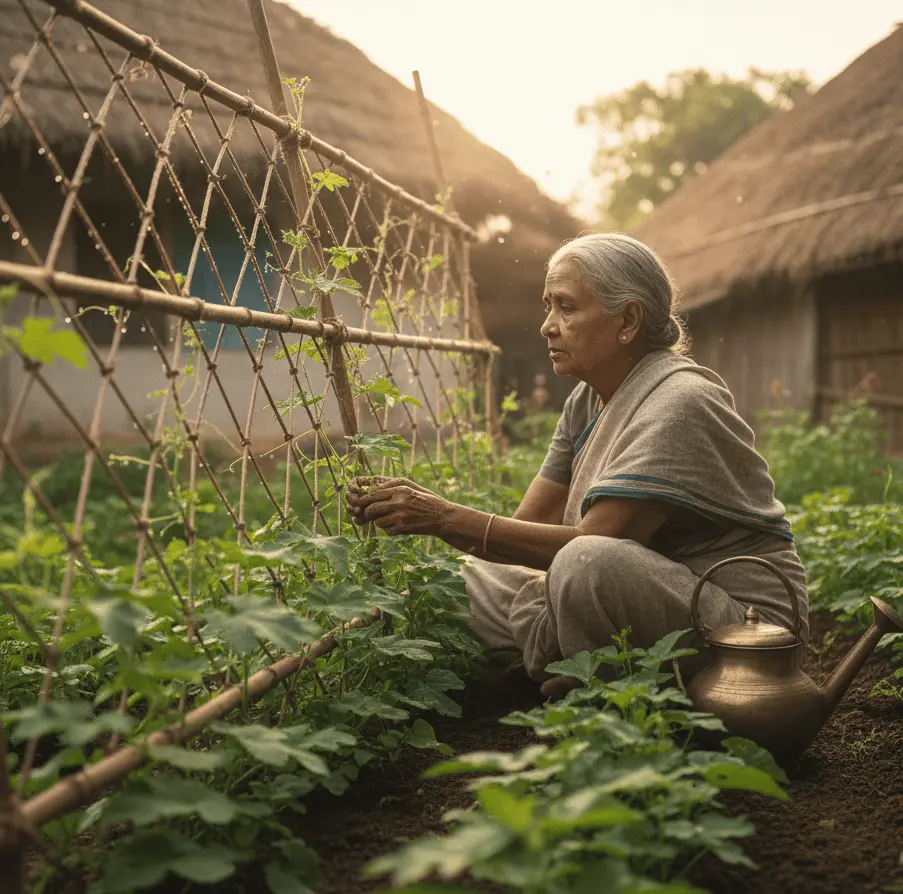
Your grandmother visited her korola plants every morning. She talked to them. She checked each leaf. She noticed problems before they became disasters.
Daily care rituals:
- Morning inspection for pest detection
- Gentle vine training to optimize sun exposure
- Stress sign recognition from leaf color and texture
- Preventive treatments using natural home remedies
- Loving attention that plants somehow understood
Modern gardeners check plants weekly if they remember. They miss early warning signs. They treat problems after damage occurs.
Plants respond to consistent, gentle care. They grow better for attentive gardeners. Love truly makes plants thrive.
Create your own morning ritual. Your korola plants will reward daily attention with superior harvests.
Natural Pest Control: Grandmother’s Arsenal
Chemical pesticides didn’t exist in grandmother’s time. She protected korola plants with kitchen ingredients and garden herbs. Her methods worked better than expensive sprays.
Traditional pest control arsenal:
- Neem leaf spray for general pest prevention
- Turmeric paste for fungal disease protection
- Mustard oil mixture to repel insects naturally
- Wood ash dusting for soil-dwelling pest control
- Companion planting with pest-repelling herbs
She understood plant partnerships. Certain herbs protected korola naturally. She created garden ecosystems that balanced themselves.
Modern pesticides kill beneficial insects too. They create pest resistance problems. They contaminate your medicine-quality korola.
Natural protection preserves korola’s healing properties. Chemical residues reduce medicinal effectiveness.
The Sacred Watering Wisdom
Water timing determined korola success in grandmother’s garden. She watered at specific times. She used specific amounts. She understood plant thirst like human thirst.
Traditional watering secrets:
- Early morning watering before sun intensity increases
- Deep, infrequent watering encourages strong root development
- Clay pot irrigation provides slow, steady moisture
- Rainwater preference over well water when possible
- Soil moisture testing with finger method
Modern drip systems work, but they lack grandmother’s intuitive timing. She adjusted watering based on plant signals and weather patterns.
Korola needs consistent moisture but hates waterlogged soil. Grandmother balanced this perfectly through experience and observation.
Master traditional watering techniques. Your korola plants will develop stronger root systems and better fruit quality.
Harvest Timing: The Critical Window
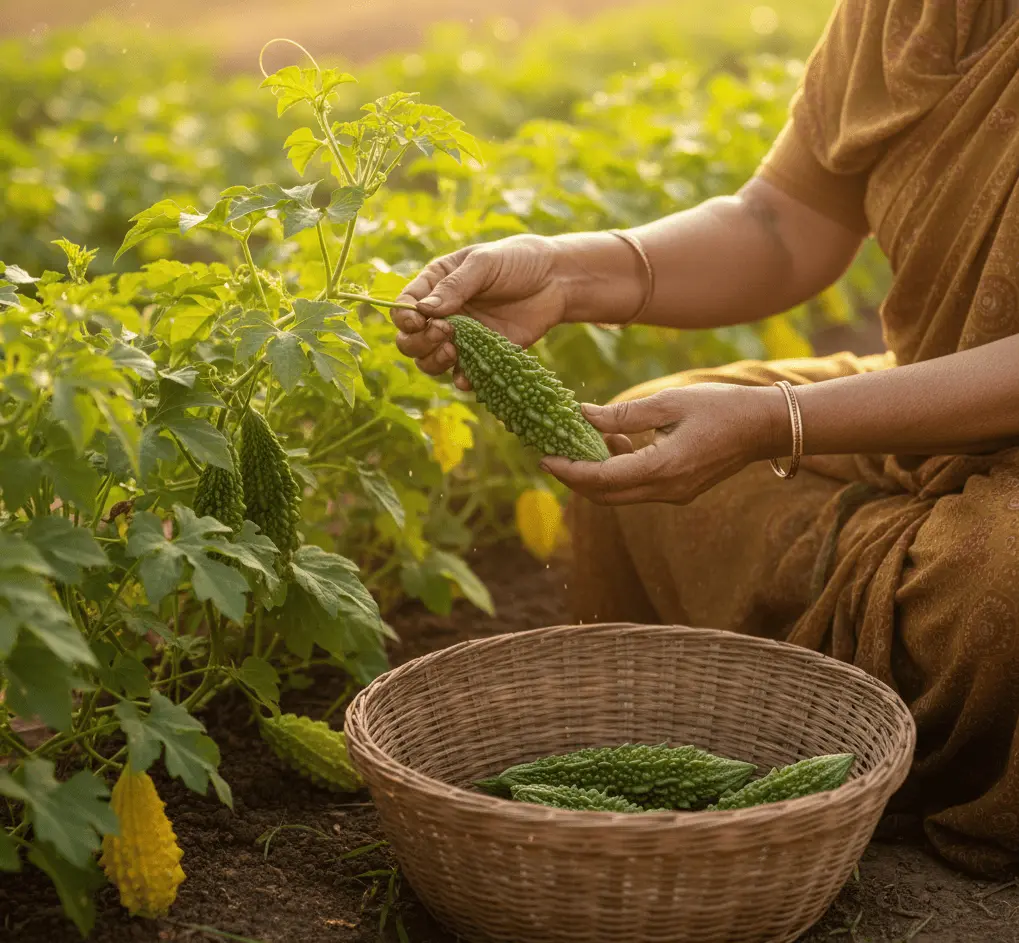
Grandmother harvested korola at exact ripeness for maximum medicinal value. Too early meant weak medicine. Too late meant bitter inedibility.
Traditional harvest indicators:
- Size measurement using hand-span method
- Color assessment for optimal green shade
- Firmness test with gentle pressure
- Seed development checked through translucency
- Timing calculation from flower to fruit maturity
Modern gardeners guess at harvest time. They miss the optimal window. They get organic bitter gourds that taste terrible or medicine that works poorly.
Perfect timing creates perfect medicine. Early morning harvest preserves maximum nutritional compounds.
Your grandmother’s korola tasted better because she picked it at peak potency. She understood the plant’s medicinal cycles.
Traditional Preparation and Storage
Raw korola tastes unbearably bitter. Grandmother knew preparation secrets that made it palatable while preserving medicinal properties.
Traditional preparation wisdom:
- Salt treatment to reduce excessive bitterness
- Proper cutting technique for optimal texture
- Timing between prep and cooking for best results
- Oil and spice combinations that enhance medicine absorption
- Storage methods that preserve potency
She never threw away korola seeds. She dried them for future planting. She understood the complete plant’s value.
Modern preparation often destroys medicinal compounds. Traditional methods preserve healing properties while improving taste.
The Health Transformation Your Grandmother Achieved
Your grandmother didn’t grow korola for fun. She grew it for family health. She understood bitter gourd as powerful medicine disguised as vegetable.
Traditional medicinal uses:
- Blood sugar regulation for diabetes management
- Liver detoxification for overall health improvement
- Digestive system support for gut health
- Immune system strengthening for disease prevention
- Skin condition treatment for natural healing
Modern research validates grandmother’s wisdom. Scientists discover compounds she knew intuitively. They create expensive supplements from knowledge she used freely.
Organic bitter gourd seeds grown traditionally produce superior medicine. Commercial varieties lack grandmother’s potency.
Want natural diabetes management? Grow korola exactly like your grandmother did. Ancient methods create modern health solutions.
Creating Your Grandmother’s Organic Bitter Gourd Garden Today
You can recreate your grandmother’s korola success today. Her methods work in modern gardens. Her wisdom transcends time and location.
Implementation steps:
- Source authentic korola seeds from traditional varieties
- Prepare soil using organic methods she would recognize
- Build bamboo supports following traditional designs
- Establish daily care routines based on her practices
- Learn harvest timing through careful observation
Modern conveniences can supplement traditional methods. Use both ancient wisdom and current knowledge for optimal results.
Success requires patience and observation. Grandmother’s methods take time but deliver superior results.
Start Your Heritage Korola Journey
Your perfect korola journey begins with authentic seeds and traditional knowledge. It continues with patient, consistent care. It succeeds through grandmother’s proven wisdom.
Ready to grow medicine like your grandmother? Order authentic korola seeds and begin your heritage health journey.
From years of helping gardeners rediscover traditional growing wisdom, I’ve learned this truth: grandmother’s methods consistently outperform modern shortcuts.
Don’t settle for weak, tasteless bitter gourds. Your family’s health deserves authentic korola grown with traditional love and wisdom.
Honor your grandmother’s legacy. Grow korola that would make her proud. Create medicine that actually heals.
Your korola garden becomes a bridge between generations. It connects you to ancestral wisdom. It preserves healing knowledge for your children.
Which grandmother secret will you try first?
I can’t find traditional soil ingredients like cow dung. What can I use instead?
No problem. You can substitute traditional ingredients with readily available organic alternatives. Use high-quality organic compost or well-rotted animal manure in place of cow dung. Neem cake is often sold online and at specialty garden centers. You can also use other organic fertilizers and amendments to build a rich, living soil ecosystem.
Can I grow bitter gourd in a container in the U.S.?
Yes, bitter gourd grows well in containers, making it a great option for patios or balconies. Just be sure to use a large container, at least 15-20 gallons, and a sturdy trellis for the vines to climb. This method allows you to control the soil and provides a good harvest even in small spaces.
Is “korola” the same as “bitter melon” or “bitter gourd”?
Yes, “korola” is the Bengali name for the vegetable, which is widely known as bitter gourd or bitter melon. While there are different varieties, the core principles of growing the plant for its medicinal properties remain the same.
Is there any scientific evidence to back up these traditional methods and health claims?
Yes, modern science is increasingly validating these traditional practices. Research has shown that heirloom varieties often contain higher concentrations of beneficial compounds. Additionally, organic and traditional soil preparation methods create a healthier growing environment, which can lead to more nutrient-dense plants. Source 1
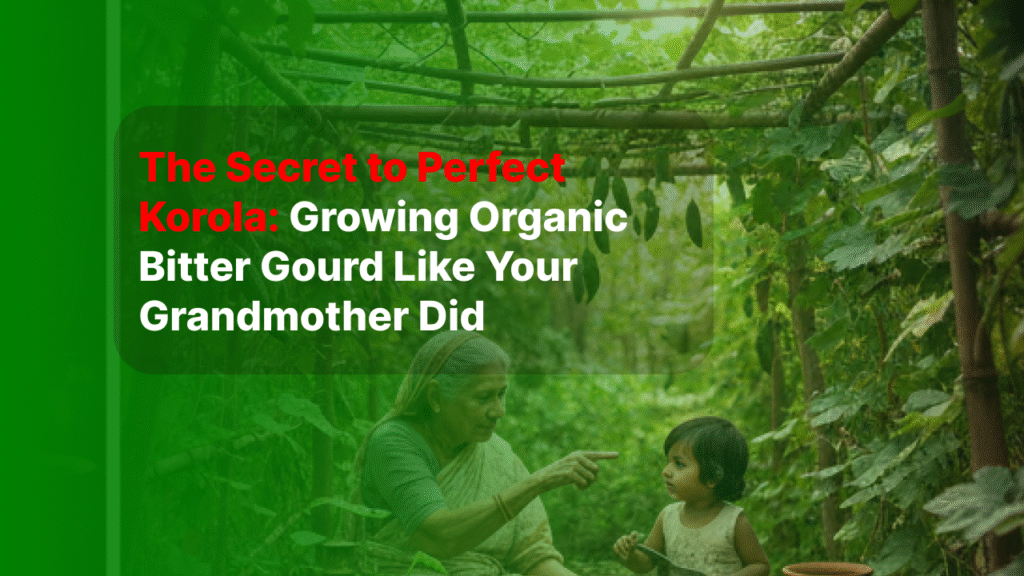


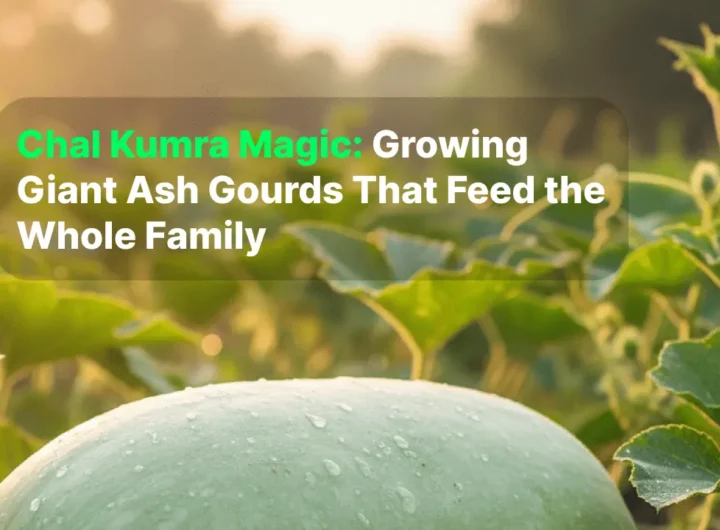

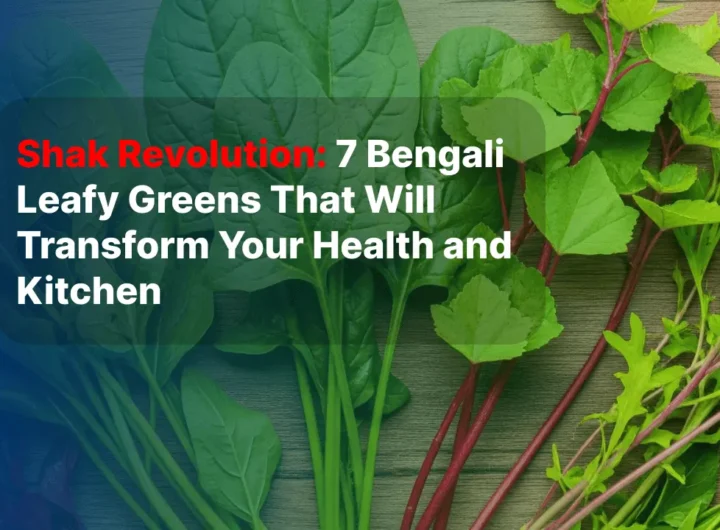


Comments ( 0 )